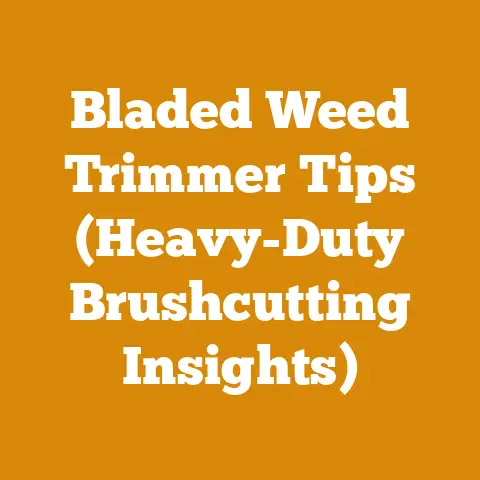Copper Sulfate Tree Kill (Root Control Secrets for Woodworkers)
Imagine this: you’ve spent weeks, maybe even months, meticulously crafting a beautiful walnut table. The finish is perfect, the joinery seamless. But then, a few months down the line, you notice the telltale signs of root intrusion near your workshop. Roots are pushing up through the concrete, threatening the very foundation of your livelihood and, more immediately, the stability of your precious wood stock. This is where the seemingly harsh topic of using copper sulfate for tree kill and root control becomes surprisingly relevant to us woodworkers.
While I’m a firm believer in the sustainable harvesting and responsible use of wood, sometimes, we’re faced with situations where removing a tree or controlling invasive root systems is necessary to protect our property, our work, and even our safety. This article isn’t about indiscriminately killing trees; it’s about understanding when and how copper sulfate can be a tool for responsible root control, especially in situations where it directly impacts our woodworking spaces and projects.
I’ve seen firsthand the damage that unchecked root growth can inflict. A friend of mine, a talented luthier, had to completely relocate his workshop after roots from a nearby oak tree cracked his foundation, causing significant moisture problems that warped his delicate instrument woods. That experience hammered home the importance of understanding root control methods, even for those of us whose primary focus is shaping wood, not felling trees.
So, let’s dive into the world of copper sulfate and its role in root control, specifically tailored for the needs and concerns of woodworkers. We’ll explore the science behind it, the safe and responsible application methods, and the alternatives available. My goal is to equip you with the knowledge to make informed decisions about protecting your workshops and wood supplies from the destructive force of unwanted roots.
Understanding Copper Sulfate: The Science Behind the Solution
Copper sulfate, also known as cupric sulfate, is an inorganic salt that has been used for centuries in various applications, from agriculture to medicine. In the context of root control, it acts as a systemic herbicide, meaning it’s absorbed by the plant and transported throughout its system, eventually disrupting vital functions and leading to its demise.
Chemical Properties and Mode of Action
Copper sulfate (CuSO₄) is a crystalline solid that, in its hydrated form (CuSO₄·5H₂O), appears as bright blue crystals. The copper ions (Cu²⁺) are the active ingredient responsible for its herbicidal effect. When dissolved in water and absorbed by plant roots, these copper ions interfere with essential enzymatic processes, particularly those involved in photosynthesis and respiration. This disruption effectively starves the plant, leading to its eventual death.
Think of it like this: copper ions gum up the works of the plant’s internal machinery. They bind to proteins and enzymes, preventing them from doing their jobs. This is particularly effective against roots because roots are constantly working to absorb water and nutrients, making them highly susceptible to the disruptive effects of copper ions.
Copper Sulfate vs. Other Herbicides: A Comparison
While copper sulfate is a relatively mild herbicide compared to some synthetic options, it’s important to understand its strengths and weaknesses.
- Glyphosate (Roundup): A broad-spectrum herbicide that inhibits an enzyme essential for plant growth. It’s more effective on a wider range of plants than copper sulfate but is also more controversial due to potential environmental and health concerns.
- Triclopyr (Garlon): A selective herbicide primarily used to control woody plants and broadleaf weeds. It’s often used for stump treatment to prevent regrowth.
- Copper Sulfate: Primarily effective on roots and algae. It’s less persistent in the environment than some synthetic herbicides but can still have negative impacts on aquatic life if used improperly.
The key difference lies in the selectivity and persistence. Glyphosate and triclopyr are designed to target specific plant processes, while copper sulfate’s effect is more general. Copper sulfate also breaks down relatively quickly in the environment, while some synthetic herbicides can persist for longer periods.
Environmental Considerations: The Double-Edged Sword
Copper is a naturally occurring element, and plants require trace amounts of it for healthy growth. However, excessive copper can be toxic to plants and other organisms. When using copper sulfate, it’s crucial to consider its potential impact on the surrounding environment.
- Soil Toxicity: High concentrations of copper in the soil can inhibit plant growth and affect soil microorganisms. It’s essential to use copper sulfate sparingly and avoid over-application.
- Aquatic Toxicity: Copper is highly toxic to aquatic life, particularly fish and invertebrates. Copper sulfate is sometimes used to control algae in ponds and lakes, but it must be done carefully to avoid harming other organisms.
- Leaching: Copper can leach from the soil into groundwater, potentially contaminating drinking water sources. It’s important to apply copper sulfate in a way that minimizes runoff and leaching.
I remember a project where I was helping a local woodworking guild clear some invasive vines from their outdoor lumber storage area. We initially considered using a broad-spectrum herbicide, but after considering the proximity to a nearby stream, we opted for a more targeted approach using copper sulfate on the vine stumps. This allowed us to control the vines without risking contamination of the water source.
The takeaway here is that copper sulfate should be used judiciously and with a full understanding of its potential environmental impacts. It’s not a “spray and forget” solution.
When to Consider Copper Sulfate for Root Control: A Woodworker’s Perspective
Now that we understand the science behind copper sulfate, let’s explore the specific situations where it might be a viable option for woodworkers dealing with root-related issues.
Protecting Your Workshop Foundation
As I mentioned earlier, root intrusion can cause significant damage to workshop foundations. Cracks in the foundation can lead to moisture problems, which can warp wood, promote mold growth, and create an unhealthy working environment.
- Identifying the Problem: Look for cracks in the foundation, particularly near trees or shrubs. Also, check for signs of moisture intrusion, such as damp spots or water stains.
- Assessing the Risk: Determine the proximity of trees to your foundation and the species of trees involved. Some species, like willows and poplars, are known for their aggressive root systems.
- Considering Alternatives: Before resorting to copper sulfate, consider other options, such as root barriers or pruning the roots of nearby trees.
In my own workshop, I had a persistent problem with roots from a silver maple tree pushing up through the concrete floor. I initially tried cutting the roots back, but they kept growing back thicker and stronger. Eventually, I decided to use copper sulfate to control the roots in a targeted area near the foundation.
Preventing Clogs in Drainage Systems
Roots can also infiltrate drainage systems, causing clogs and backups. This can be a particular problem in workshops with floor drains or septic systems.
- Identifying the Problem: Look for slow drains or backups in your plumbing system. You may also notice roots growing out of drainpipes or septic tanks.
- Assessing the Risk: Determine the proximity of trees to your drainage system and the type of pipes involved. Older clay or cast iron pipes are more susceptible to root intrusion than newer PVC pipes.
- Considering Alternatives: Before using copper sulfate, try mechanical methods of clearing the drains, such as using a plumber’s snake or hydro jetting.
I once helped a fellow woodworker unclog his septic system after it had been completely blocked by roots from a nearby oak tree. We ended up having to dig up the entire septic tank and replace the drain field. It was a costly and time-consuming process that could have been avoided with preventative root control measures.
Controlling Invasive Tree Species
In some cases, you may need to remove an entire tree to protect your property or prevent the spread of invasive species. Copper sulfate can be used to kill trees by applying it directly to the stump.
- Identifying the Problem: Determine if a tree is posing a threat to your property or is an invasive species that needs to be removed.
- Assessing the Risk: Consider the size and location of the tree, as well as the potential impact on the surrounding environment.
- Considering Alternatives: Before using copper sulfate, consider other tree removal methods, such as cutting the tree down and grinding the stump.
I’ve worked on several projects where we had to remove invasive tree species, such as ailanthus (tree-of-heaven), to restore native habitats. In these cases, we often used copper sulfate to prevent the trees from resprouting from the stump.
Important Considerations Before Using Copper Sulfate
Before you reach for the copper sulfate, it’s crucial to consider the following factors:
- Tree Species: Copper sulfate is more effective on some tree species than others. It’s generally more effective on deciduous trees with shallow root systems.
- Soil Type: The effectiveness of copper sulfate can be affected by soil type. It’s less effective in alkaline soils, as the copper ions are less soluble.
- Proximity to Water Sources: Avoid using copper sulfate near streams, lakes, or wells, as it can contaminate the water.
- Local Regulations: Check your local regulations regarding the use of herbicides. Some areas may have restrictions on the use of copper sulfate.
Always err on the side of caution and consult with a qualified arborist or pest control professional before using copper sulfate. They can help you assess the situation and determine the best course of action.
Safe and Effective Application Techniques: A Step-by-Step Guide
If you’ve determined that copper sulfate is the right solution for your root control problem, it’s crucial to apply it safely and effectively. Here’s a step-by-step guide:
Safety Precautions: Protecting Yourself and the Environment
Copper sulfate can be irritating to the skin, eyes, and respiratory system. It’s important to take the following precautions when handling it:
- Wear protective clothing: Wear long sleeves, pants, gloves, and eye protection.
- Avoid inhalation: Wear a dust mask or respirator when handling the powder form of copper sulfate.
- Wash thoroughly: Wash your hands and any exposed skin after handling copper sulfate.
- Keep away from children and pets: Store copper sulfate in a secure location out of reach of children and pets.
I always make sure to have a well-stocked first-aid kit on hand when working with any chemicals, including copper sulfate. It’s also a good idea to have a source of clean water nearby in case of accidental exposure.
Application Methods: Choosing the Right Approach
There are several ways to apply copper sulfate for root control, depending on the situation.
- Root Killer in Sewer Lines: For sewer line applications, copper sulfate crystals can be flushed down the toilet. Follow the manufacturer’s instructions carefully and avoid over-application. Typically, you’d use about a half-cup of copper sulfate crystals, flushing half down the toilet and waiting 15-30 minutes before flushing the rest. Repeat monthly.
- Foaming Root Killer: A foaming root killer, often containing Dichlobenil, expands to fill the pipe, maximizing contact with roots. Follow the product’s instructions for application.
- Direct Application to Roots: For roots that are exposed or accessible, you can apply a solution of copper sulfate directly to the roots using a sprayer or brush. Mix the copper sulfate with water according to the manufacturer’s instructions.
- Stump Treatment: To prevent regrowth from tree stumps, you can apply a concentrated solution of copper sulfate to the freshly cut stump. Drill holes into the stump and pour the solution into the holes to ensure thorough penetration.
I’ve found that the stump treatment method is particularly effective for preventing resprouting from invasive tree species. I usually drill several holes around the perimeter of the stump and fill them with a concentrated solution of copper sulfate. I then cover the stump with a tarp to prevent rain from diluting the solution.
Dosage and Concentration: Getting the Right Balance
The correct dosage and concentration of copper sulfate are crucial for effective root control. Too little, and it won’t be effective. Too much, and you risk damaging the environment.
- Follow the Manufacturer’s Instructions: Always follow the manufacturer’s instructions on the product label. These instructions will provide specific dosage recommendations for different applications.
- Start with a Low Dose: It’s always better to start with a low dose and increase it if necessary. I’d rather have to reapply the copper sulfate than risk damaging the environment.
Monitoring and Follow-Up: Ensuring Long-Term Control
After applying copper sulfate, it’s important to monitor the situation and follow up as needed.
- Check for Signs of Root Regrowth: Monitor the treated area for signs of root regrowth. If you see new growth, you may need to reapply the copper sulfate.
- Inspect Drainage Systems: Regularly inspect your drainage systems for clogs or backups. If you notice any problems, you may need to reapply the copper sulfate.
- Adjust Your Approach: If the copper sulfate is not effective, you may need to try a different approach, such as using a different herbicide or physically removing the roots.
Root control is often an ongoing process. It’s important to be vigilant and take action as needed to prevent root-related problems from recurring.
Alternatives to Copper Sulfate: Exploring Other Options
While copper sulfate can be an effective tool for root control, it’s not always the best option. There are several alternatives that you may want to consider, depending on the situation.
Physical Barriers: Preventing Root Intrusion
Physical barriers can be used to prevent roots from growing into unwanted areas. These barriers can be made of various materials, such as plastic, metal, or fabric.
- Root Barriers: These are installed around trees or shrubs to prevent their roots from spreading. They can be used to protect foundations, drainage systems, and other structures.
- Geotextiles: These are permeable fabrics that can be used to create a barrier between the soil and the roots. They are often used in landscaping applications to prevent roots from growing into flower beds or gardens.
- Concrete Barriers: These are used to create a physical barrier between trees and structures. They are often used in urban environments to protect sidewalks and buildings.
I’ve used root barriers extensively in my own landscaping projects. They’re a great way to prevent roots from damaging structures without having to resort to herbicides.
Mechanical Removal: A Hands-On Approach
Mechanical removal involves physically removing the roots that are causing problems. This can be done using various tools, such as shovels, saws, and root cutters.
- Root Pruning: This involves cutting back the roots of a tree or shrub to prevent them from growing into unwanted areas.
- Root Grinding: This involves grinding up the roots of a tree or shrub using a specialized machine. This is often used to remove stumps and roots after a tree has been cut down.
- Drain Cleaning: This involves using a plumber’s snake or hydro jetting to clear roots from drainage systems.
Mechanical removal can be a labor-intensive process, but it’s often the most effective way to eliminate root problems.
Biological Control: Harnessing Nature’s Power
Biological control involves using natural enemies to control root growth. This can include using beneficial fungi or bacteria that attack roots.
- Mycorrhizal Fungi: These fungi form a symbiotic relationship with plant roots, helping them to absorb water and nutrients. Some mycorrhizal fungi can also help to protect roots from disease and pests.
- Beneficial Bacteria: Some bacteria can produce enzymes that break down root tissue, preventing roots from growing too aggressively.
Biological control is a relatively new approach to root control, but it has the potential to be a sustainable and environmentally friendly solution.
Herbicides: A Last Resort
If other methods have failed, you may need to resort to using herbicides to control root growth. However, herbicides should be used as a last resort, as they can have negative impacts on the environment.
- Glyphosate (Roundup): This is a broad-spectrum herbicide that can be used to kill a wide range of plants, including trees and shrubs.
- Triclopyr (Garlon): This is a selective herbicide that is primarily used to control woody plants and broadleaf weeds.
- Imazapyr (Arsenal): This is a systemic herbicide that is used to control a wide range of plants, including trees, shrubs, and grasses.
When using herbicides, it’s important to follow the manufacturer’s instructions carefully and take precautions to protect yourself and the environment.
Case Studies: Real-World Examples of Root Control in Woodworking Settings
To illustrate the practical application of root control techniques, let’s look at a few case studies involving woodworking settings.
Case Study 1: Protecting a Workshop Foundation from Tree Roots
A woodworker in a rural area noticed cracks in the foundation of his workshop, which was located near a large oak tree. He suspected that the tree’s roots were the cause of the damage.
- Assessment: He consulted with an arborist, who confirmed that the tree’s roots were indeed growing under the foundation and causing it to crack.
- Solution: The woodworker decided to install a root barrier along the foundation to prevent the roots from growing any further. He also pruned the roots of the tree to reduce its overall root mass.
- Outcome: The root barrier effectively prevented the roots from causing further damage to the foundation. The woodworker was able to repair the cracks and prevent future problems.
Case Study 2: Clearing Roots from a Workshop Drainage System
A woodworker in an urban area experienced frequent backups in his workshop’s drainage system. He suspected that tree roots were the cause of the problem.
- Assessment: He hired a plumber to inspect the drainage system, who found that it was clogged with tree roots.
- Solution: The plumber used a hydro jetting machine to clear the roots from the drainage system. He also recommended that the woodworker use a root killer on a regular basis to prevent future clogs.
- Outcome: The hydro jetting effectively cleared the roots from the drainage system. The woodworker followed the plumber’s recommendation and used a root killer on a regular basis, which prevented future clogs.
Case Study 3: Removing an Invasive Tree Species from a Woodworking Site
A woodworking guild in a suburban area wanted to remove an invasive tree species from their outdoor lumber storage area.
- Assessment: The guild members identified the tree as ailanthus (tree-of-heaven), an invasive species that is known for its aggressive growth and ability to resprout from the stump.
- Solution: The guild members cut down the tree and applied a concentrated solution of copper sulfate to the stump to prevent it from resprouting.
- Outcome: The copper sulfate effectively prevented the tree from resprouting. The guild members were able to remove the invasive species and restore the area to its natural state.
These case studies illustrate the importance of identifying root-related problems early and taking appropriate action to prevent further damage. They also demonstrate the effectiveness of various root control techniques, including physical barriers, mechanical removal, and herbicides.
The Future of Root Control: Innovations and Sustainable Solutions
The field of root control is constantly evolving, with new technologies and approaches being developed all the time. Here are a few trends to watch for in the future:
Precision Application Techniques: Minimizing Environmental Impact
Researchers are developing new techniques for applying herbicides with greater precision, minimizing the amount of chemical that is released into the environment.
- Targeted Sprayers: These sprayers use sensors to detect the presence of weeds or roots and apply herbicide only to those areas.
- Micro-Injection: This involves injecting herbicide directly into the root system of a tree or shrub, minimizing the amount of chemical that is released into the soil.
These precision application techniques have the potential to significantly reduce the environmental impact of herbicide use.
Bioremediation: Using Natural Processes to Clean Up Contamination
Bioremediation involves using microorganisms to break down pollutants in the soil and water. This can be used to clean up areas that have been contaminated with herbicides or other chemicals.
- Phytoremediation: This involves using plants to absorb pollutants from the soil.
- Microbial Remediation: This involves using bacteria or fungi to break down pollutants in the soil.
Bioremediation is a promising approach to cleaning up contaminated sites and restoring them to their natural state.
Sustainable Root Control Strategies: A Holistic Approach
The future of root control lies in adopting a more holistic approach that considers the long-term sustainability of the environment.
- Integrated Pest Management (IPM): This involves using a combination of techniques to control pests, including cultural practices, biological control, and chemical control.
- Green Infrastructure: This involves using natural systems to manage stormwater and other environmental challenges.
By adopting a more sustainable approach to root control, we can protect our environment and ensure that our woodworking spaces remain healthy and productive for years to come.
Final Thoughts: Protecting Your Woodworking Haven
As woodworkers, we have a deep appreciation for the natural world and the materials it provides. It’s our responsibility to use those materials sustainably and to protect the environment that sustains us. While the thought of using chemicals like copper sulfate might seem counterintuitive to our craft, understanding its purpose and application in root control can be a valuable tool in protecting our workshops and ensuring the longevity of our woodworking havens.
Remember, responsible root control is about more than just killing trees. It’s about protecting our property, our work, and our safety. By understanding the science behind copper sulfate, the safe and effective application methods, and the alternatives available, we can make informed decisions about how to manage root-related problems in a way that is both effective and environmentally responsible.
My hope is that this article has provided you with the knowledge and tools you need to protect your woodworking space from the destructive force of unwanted roots. So, the next time you see a crack in your foundation or a clog in your drainage system, you’ll be prepared to take action and protect your woodworking haven for years to come. Now, go forth and create, knowing that you’re equipped to handle whatever nature throws your way!






